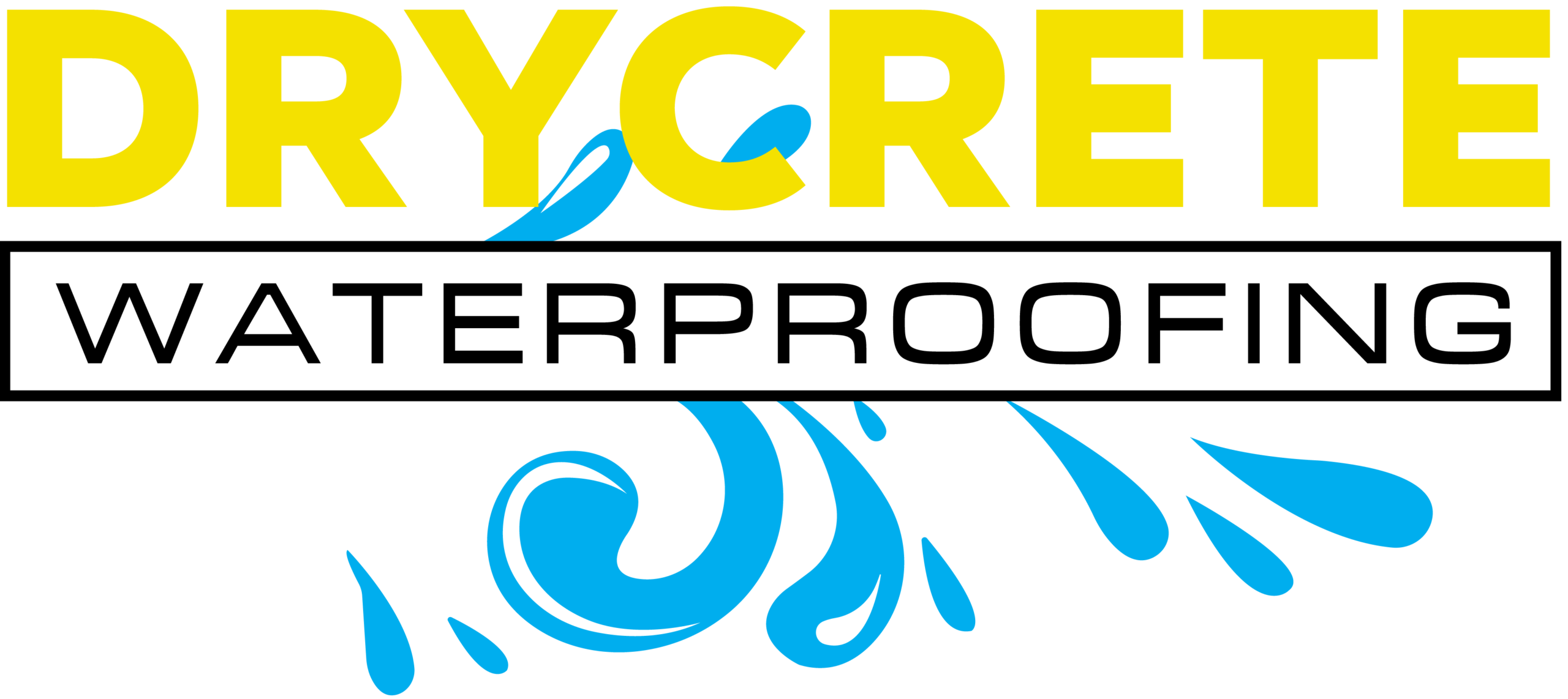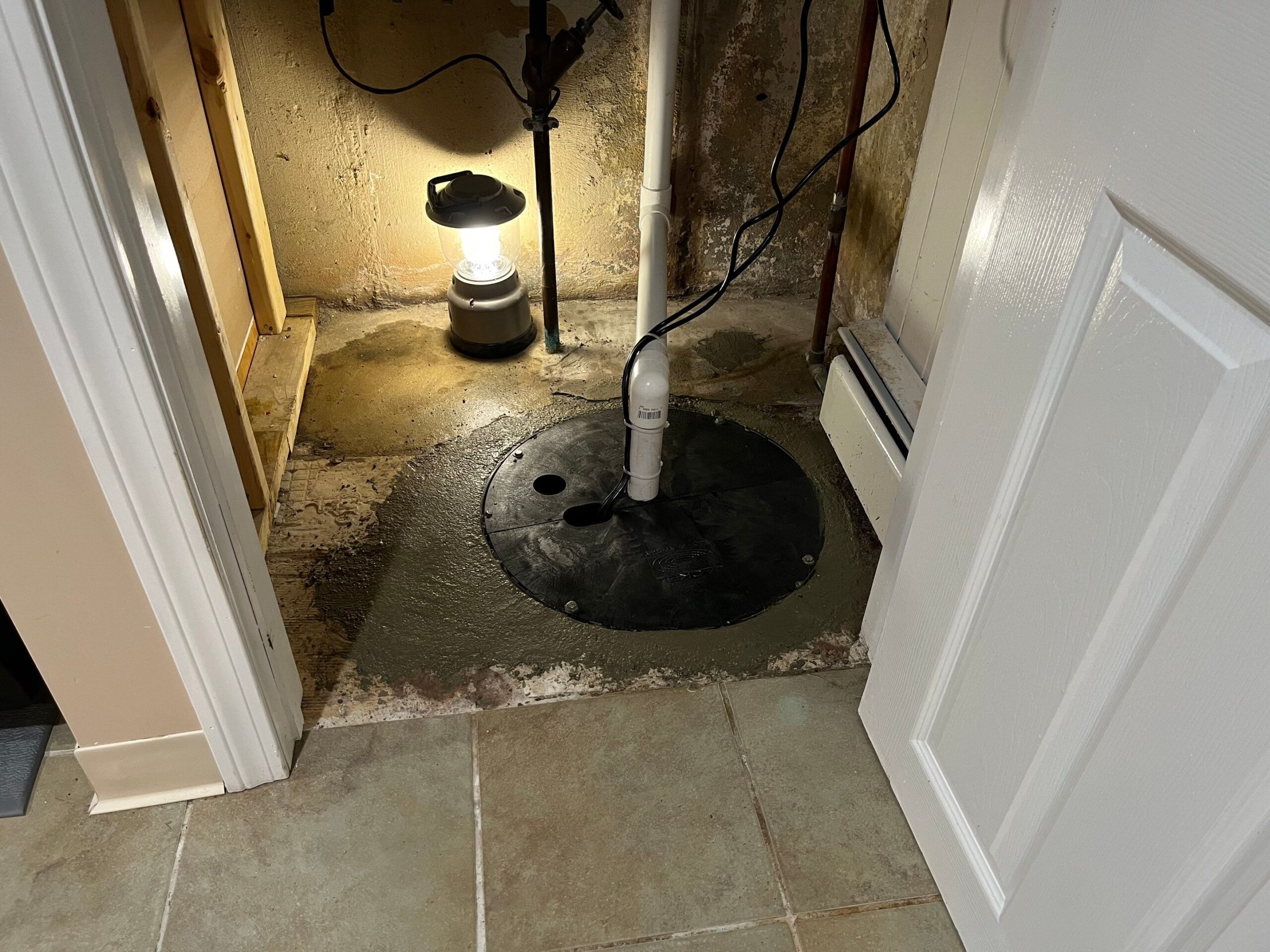The key to basement waterproofing is not stopping water, but managing where it goes. A sump pump is the heart of any basement waterproofing system. Water that would otherwise be in your basement, collects in your sump pit and is pumped out and away from your home by your sump pump. You don’t have to be an expert to understand what a sump pump is and how it works. Having knowledge of the components that keep your house safe from water damage can go a long way in helping you make the right decisions for your home’s health and longevity.
What is a sump pump?
To truly understand what a sump pump is and how it works you must know the three major components that allow a sump pump to do its job.
- The Sump Pump: A sump pump is a device that is designed to pump water that collects in a sump pit out and away from your home.
- The Sump Pit: A sump pit is a pit or container recessed into your concrete slab at the lowest point in your basement. It is designed to collect and contain water that accumulates in your basement or crawlspace.
- The Discharge Line: A discharge line, as the name suggests, is a pipe that discharges water, propelled by your sump pump, out of your basement and away from your home.
How does a sump pump work?
So how exactly does it all work together? Your sump pump is made up of multiple parts. One of which is a float switch. As the water level rises in your sump pit your float switch is designed to do just as the name suggests, float on top of the water. Once the float switch rises high enough, your sump pump is activated.
Once activated the sump pump uses an electric motor to power an impeller, a small fan-like device that spins rapidly. This creates a low-pressure area that draws water through the pump and pushes it out of your discharge line. Your discharge line is cored through your foundation or siding and leads outside of your home and away from your foundation.
Once the water level in the sump pit drops below a certain point, the float switch is no longer triggered, and the sump pump turns off. To prevent the pumped water from flowing back into the sump pit, a check valve is installed at the base discharge pipe. Top of Form
Where should a sump pump drain to?
Each home will have a unique set of circumstances that determines the best drainage option for your sump pump. At Drycrete Waterproofing we assess a variety of factors before installing your pump and discharge line. Those include:
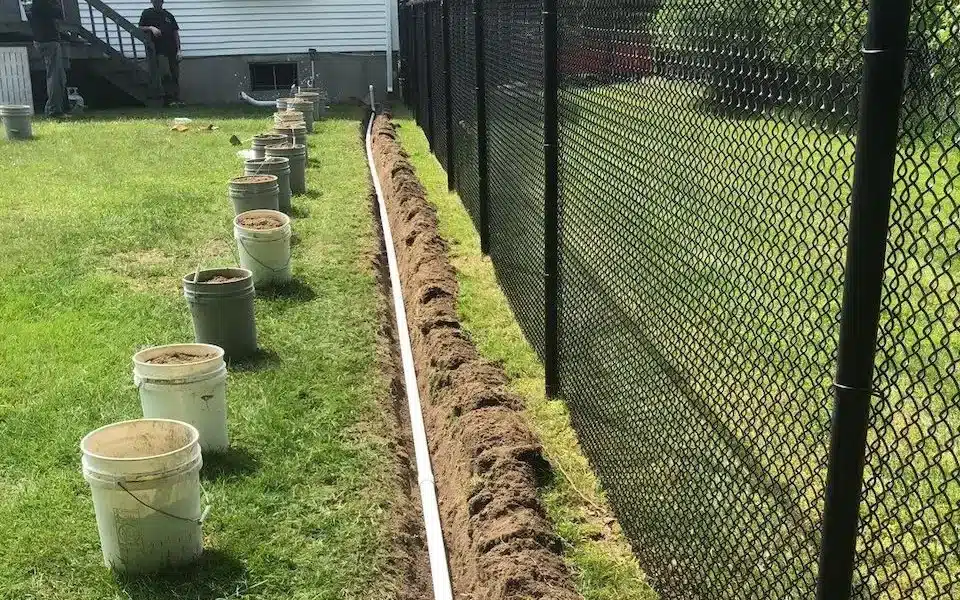
- Grade of your land: AKA does your land slope towards or away from your foundation, or is it completely flat? You should do your best to discharge a sump pump in an area where water can flow downhill and away from your foundation, rather than right back towards it.
- Saturation of your yard: Due to a variety of reasons such as soil composition, grade of your land, and the height of your water table, your yard can have a difficult time draining. If this is the case discharging your sump pump in this area can lead to recirculation, flooding, and pest infestation.
- Neighboring infrastructure: It’s important to consider where your discharged water might end up. In New England we worry about water freezing on driveways or in the street. We’re also mindful of the effects discharged water can have on your neighbor’s home. Water that leaves your house might end up flooding their lawn or basement.
- Vegetation and landscaping: Knowing if you have delicate or hardy vegetation in your garden can determine where we discharge your sump pump. Some plants will die if given too much water, some can help soak up additional moisture in the soil.
- Local regulations: We always check local regulations as there may be specific guidelines on where the water can be discharged. For instance, some towns have restrictions on discharging into storm drains or public sewage systems.
Additional work can be completed to mitigate the drainage issues from sump pump discharge such as, underground discharge pipe extensions, dry well installations, rain gardens, retention/detention ponds, dry creek beds, water collection for irrigation, and grading and landscaping.
Types of sump pumps
There are various types of sump pumps that you may come in contact with, each with their pros and cons.
Submersible Sump Pump:
This type of sump pump is designed to be submerged in the sump pit. It is sealed to prevent water from entering the motor and electrical components. Submersible sump pumps are typically more powerful and quieter than pedestal pumps. They are suitable for larger sump pits or when a higher pumping capacity is required.

Pedestal Sump Pump:
Pedestal sump pumps have a motor that is positioned above the sump pit, while the pump is located inside the pit. The motor is not designed to be submerged in water. Pedestal pumps are generally less expensive than submersible pumps and are easier to service. However, they can be louder and less powerful.
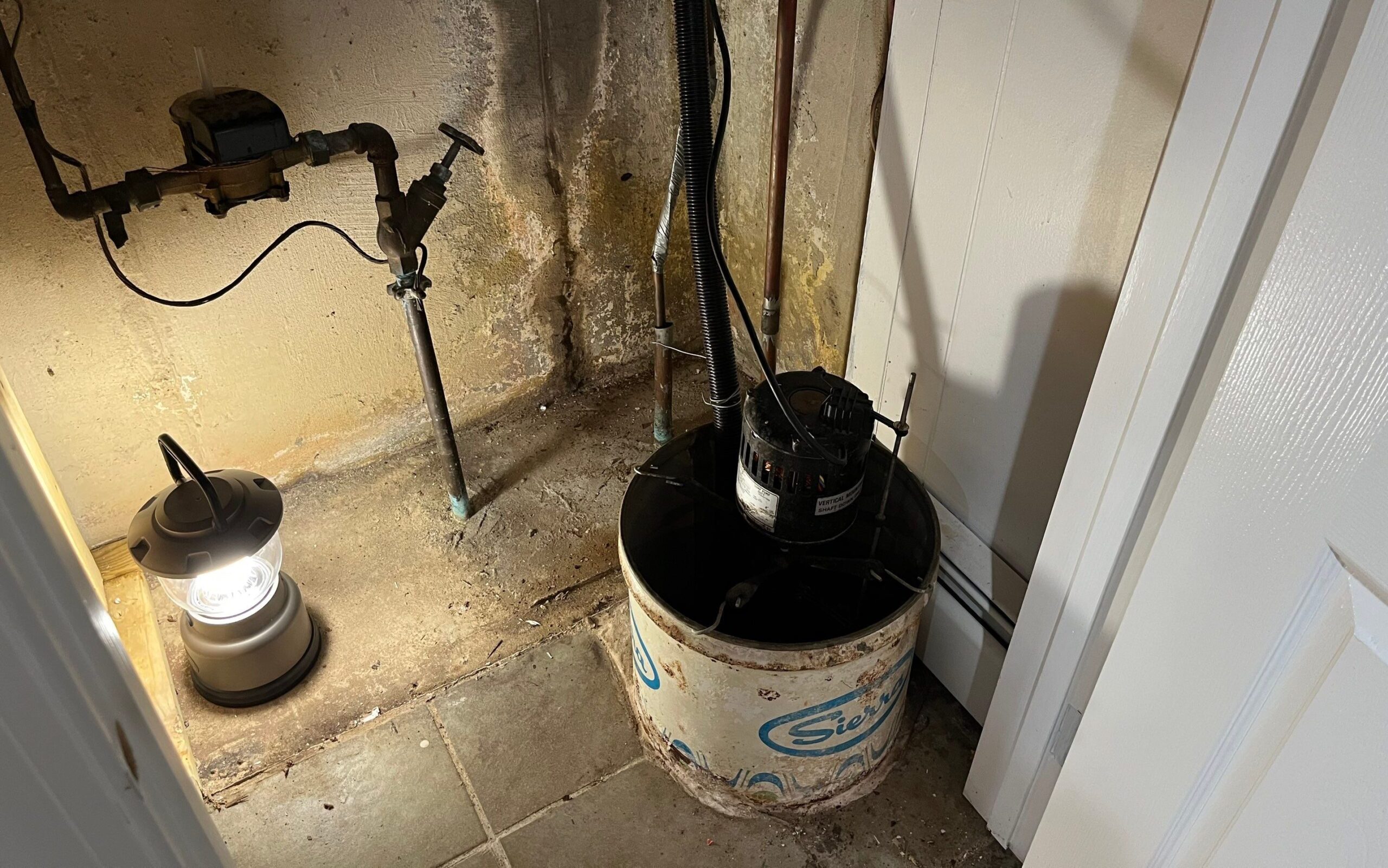
Battery Backup Sump Pump:
Battery backup sump pumps are designed to provide emergency power in case of a power outage. They work in conjunction with the primary sump pump and activate automatically when the main pump fails or when there is no electricity. Battery backup pumps are typically either submersible or pedestal pumps and help ensure continuous operation during power disruptions.

Combination Sump Pump System:
A combination sump pump system incorporates both a primary pump and a battery backup pump in a single unit. This type of system provides the benefits of a primary pump for normal conditions and a backup pump for power outages or pump failure.

Water-Powered Sump Pump:
Water-powered sump pumps operate using the water pressure from a municipal water supply. They do not require electricity or batteries but instead use the force of the flowing water to create suction and pump out water. Water-powered pumps are typically used as backup pumps and are limited in their pumping capacity compared to electric pumps.
Effluent Sump Pump:
Effluent pumps are designed to handle water that may contain small solids or debris, making them suitable for applications such as septic systems or laundry discharge. They have a higher pumping capacity and are built to handle more demanding conditions.
What sump pump do I need?
What type of sump pump you need for your basement or crawl space is going to vary based on the specific needs of your home. If you are installing your own sump pump, then it is important to do the following:
- Evaluate your needs: Assess your specific requirements by considering factors such as the size of your basement or crawl space, the average water volume you expect to encounter, and any specific challenges or features of your property that may impact water accumulation.
- Determine the pump capacity: Calculate the required pumping capacity based on the potential water volume you anticipate. This is typically measured in gallons per hour (GPH) or gallons per minute (GPM). The capacity should be sufficient to handle the highest expected water influx.
- Consider the power source: Determine whether you prefer an electric-powered sump pump or if a water-powered or battery backup pump is necessary for your needs. Electric pumps are the most common, but backup options can provide peace of mind during power outages or in areas with unreliable electricity.
- Evaluate the sump pit size: Measure the dimensions of your sump pit to ensure the sump pump you choose fits properly. Consider the available space and any installation limitations.
- Compare submersible and pedestal pumps: Decide between a submersible or pedestal sump pump. Submersible pumps are submerged in the sump pit and tend to be quieter and more powerful but are typically more expensive. Pedestal pumps have a motor positioned above the pit and are less expensive but can be noisier.
- Assess backup options: Determine if you need a battery backup sump pump or a combination system. If power outages are a concern or if you want extra protection, a battery backup or combination system can ensure continuous pumping.
- Consider durability and quality: Look for sump pumps from reputable manufacturers known for producing reliable and durable products. Check customer reviews and ratings to gauge the reliability and performance of different models. Many sump pumps will come with a manufacturer’s warranty of 3 to 5 years so be sure to familiarize yourself with the ins and outs of the warranty.
- Review additional features: Consider additional features such as built-in alarms, automatic switch mechanisms, adjustable float switches, and silencing check valves. These features can enhance convenience and provide additional protection against flooding.
4 most common types of sump pump switches
1. Vertical Float Switch:
This type of float switch is mounted vertically on the pump. It moves up and down along a rod as the water level changes. When the float rises to a certain level, it activates the switch to start the pump. As the water level drops, the float moves down, turning off the pump.
2. Tethered Float Switch:
Tethered float switches have a float attached to a flexible tether. The float moves freely with the water level, and the length of the tether determines the activation and deactivation points. When the water level rises to a specific level, the float rises and triggers the switch, turning on the pump. When the water level decreases, the float descends, and the tether pulls the switch, turning off the pump.
3. Electronic Switch:
Electronic switches use sensors to detect changes in water level. They can utilize different technologies such as pressure sensors, capacitance sensors, or conductance sensors. These switches offer more precise control over the activation and deactivation points and can be less prone to mechanical issues compared to traditional float switches.
4. Diaphragm Pressure Switch:
Diaphragm pressure switches use water pressure to activate the switch. As the water level rises, the pressure on a flexible diaphragm increases, triggering the switch to turn on the pump. When the water level drops, the pressure decreases, and the diaphragm releases the switch, turning off the pump.
When in doubt consult professionals:
Drycrete Waterproofing has been in business for over 30 years. In that time, we’ve seen our fair share of bad pumps and malfunctioning components. Our experience has allowed us to develop a sump pump system that we’re extremely proud of. Your sump pump is your first and last line of defense against water damage in your home, so reliability is key. Here’s what we install:
Premium Standard Sump Pump
Our Premium Standard Sump Pump is a submersible ¾ horsepower pump with a capacity of 3,702 gallons/hour at 10 feet of lift. It features a cast iron base which helps dissipate heat production and a stainless-steel housing that allows more robust components in a smaller space. Our sump pumps come equipped with a silencing check valve to prevent knocking that sometimes occurs in traditional check valves and an independent vertical float switch rated up to 1 million cycles. This independent float switch allows us to make small adjustments to the height of your switch, reducing frequency of cycles.
Dual Pump Battery Backup with or without Wi-fi Monitoring
Drycrete also offers a dual pump battery backup system with or without Wi-Fi monitoring. This system includes our Premium ¾ Horsepower Pump, as well as a 1/3 Horsepower Backup Pump which boasts an additional pumping capacity of 2,580 gallons per hour at 10 feet of lift. The system comes with a battery backup unit which can pump up to 13,000 gallons of water on a single charge and is used to power the backup pump in case of a power outage. The backup pump can be used in conjunction with your main pump to increase pumping capacity or as a backup for main pump failures. You have the option to pair Wi-Fi monitoring with this system which gives you access to our Smartshield app. The app allows you to monitor your pump’s cycle history and receive alerts if anything goes wrong with your pump.
Cost of a sump pump
The cost of a new sump pump can vary widely in price. You can expect to pay anywhere from $100 to $4,000 dollars for a new pump. You might be asking yourself how can that large of a price discrepancy occur? That has to do with the quality of the pump, the various components included with the system, and whether you’re having it professionally installed.
Factors that impact the cost of a sump pump:
- Quality of the Pump: The quality of the sump pump plays a significant role in determining its price. High-quality sump pumps are generally more durable, reliable, and equipped with advanced features to handle heavy water inflows effectively. These pumps are often made from superior materials and come with longer warranties, which can contribute to a higher initial cost.
- Components and Features: The components and features that come with the sump pump can also influence its cost. Some pumps may include additional features such as battery backup systems, water level alarms, or Wi-Fi connectivity for remote monitoring and control.
- Professional Installation: Another critical factor affecting the overall cost of a sump pump is the installation process. The cost of professional installation will vary depending on the complexity of the job and the region’s labor rates.
- Type and Capacity: The type and capacity of the sump pump also impact its cost. There are various types of sump pumps, including submersible and pedestal models, each with its own pricing based on their design and specifications. Additionally, the capacity of the pump, usually measured in gallons per hour (GPH), affects its price. Higher capacity pumps capable of handling larger water volumes generally come at a higher cost than lower-capacity alternatives.
- Brand Reputation: Brand reputation and recognition can also contribute to the variation in sump pump prices. Established and reputable brands that have a history of producing reliable and efficient sump pumps may charge a premium for their products.
- Other factors: There are other factors that will influence the total cost of your sump pump install. Do you have to install a sump pit? Discharge line? Do you have the equipment to do so? Does the sump pump come with all relevant components such as check valves?
Is it necessary to install a sump pump?
Whether or not you need to install a sump pump depends on the history of water issues in your home. Basements that are prone to flooding or to any kind of water accumulation on the floor should have a sump pump to help remove that water as quickly as possible. Additionally, if you haven’t lived in the home for long, or are building a new home, you should consider whether your area receives heavy rainfall, where the water table sits on your property, and proximity to areas of concern such as ponds and wetlands.
Even if you have never experienced flooding in your basement and you don’t anticipate water intrusion issues in the future, you should consider having a sump pump installed as insurance. The water table can change over time and factors such as development of land in your area, landscaping, or natural geological patterns can affect the flow of water on your property. A sump pump can also act as a line of defense against catastrophic issues caused by other basement leaks such as water tank leaks or burst pipes. If you plan to finish your basement and are hoping to have the area insured then you may be required to have some basement waterproofing systems in place such as sump pumps or French drains.
Alternatives to sump pump installation
There is no alternative to a sump pump. Your sump pump is the motor that drives your basement waterproofing system and without it your last line of defense against water intrusion is nonexistent. However, there are other waterproofing solutions that can be implemented before installing, or in conjunction with a sump pump.
- French drains (interior basement drain): These are perforated pipes installed under the slab around the perimeter of your basement. The purpose of French drains is to reduce hydrostatic pressure and direct ground water to your sump pit where your pump can remove the water from your home.
- Crack injections: If you have a leaking crack, rebar, or pipe core out in your foundation wall you can repair that with an injection material that stops water from seeping through.
- Gutter maintenance: Gutters are a water management system designed to control where water running off your roof ends up. If your gutters or downspouts are damaged, clogged, or improperly installed that can lead to pooling of water around your foundation, causing water to leak over the top of your foundation wall.
- Grading your yard: Grading your yard is a technique that refers to landscaping the soil around your home to ensure it slopes away from your foundation. That will encourage water to always run away from your home.
Causes of sump pump failure:
Just like any other mechanical system a sump pump is susceptible to failure. The life of a sump pump can be greatly increased by performing regular maintenance on the pump. Conversely, there are a variety of factors that can shorten the life of a sump pump, such as:
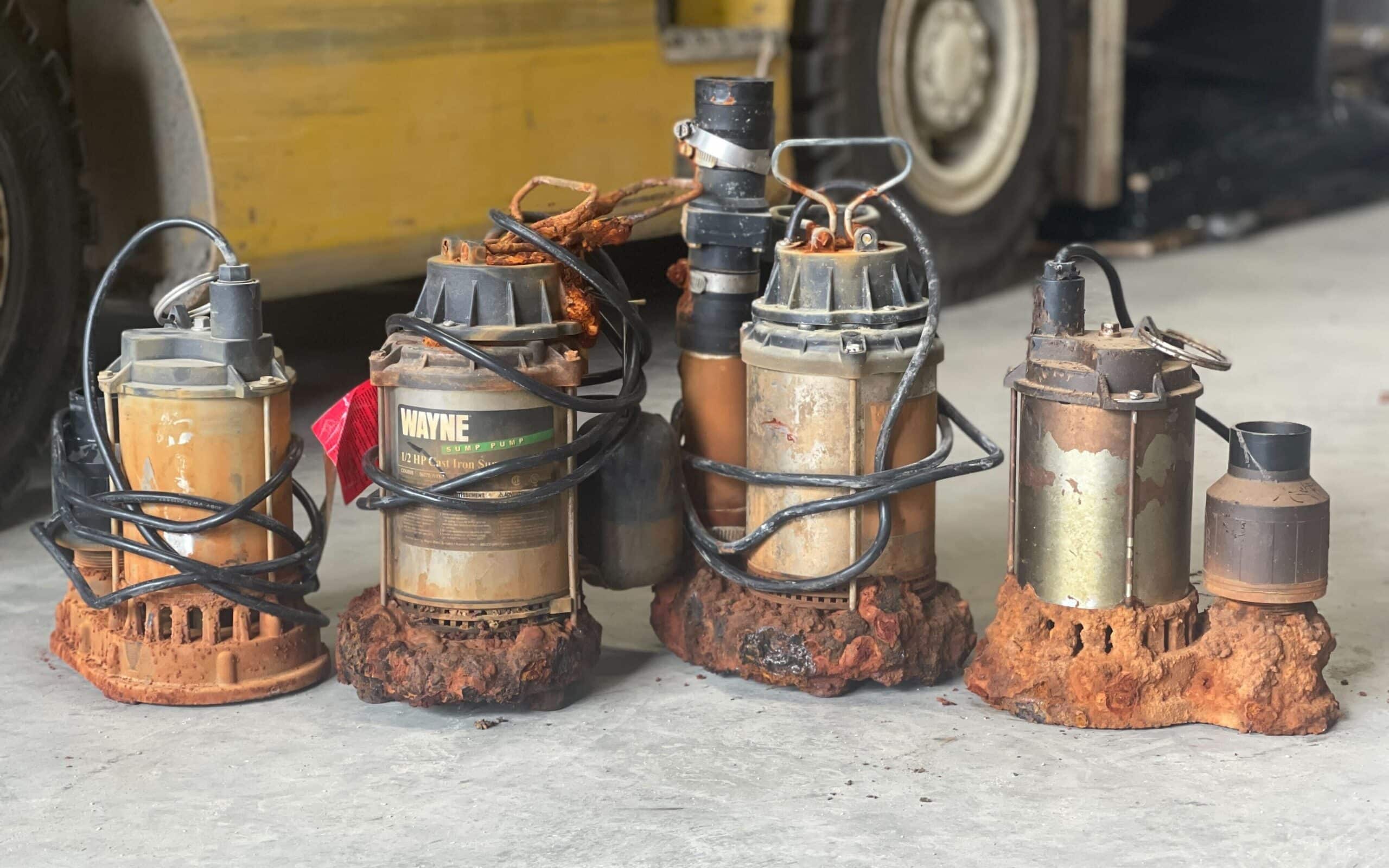
- Iron ochre build up
- Inadequate pumping power
- Faulty float switch
- Clogged or frozen discharge line
- Broken check valve
- Debris in the impeller
When should you replace your sump pump?
A good sump pump life cycle with proper maintenance is about 10 years. If your sump pump is approaching 10 years of operation, then you should schedule an annual inspection if you do not already do so. A professional can tell you what type of condition your pump is in and whether it’s time to replace it. There are a handful of warning signs that may also let you know that your sump pump is on its last leg. Those include:
- Excessive noise: Excessive noise from your sump pump can be caused by a variety of factors. Some sump pumps are naturally quieter than others so if you have a new sump pump take note of what normal functioning sounds like. No matter how loud your sump pump is, if you hear noises such as grinding, rattling, or knocking this may be a sign of something malfunctioning. Rattling that seems to shake your whole house can also be caused by coring your discharge line through your siding rather than your foundation, which has sound deadening effects.
- Continuous running: If your sump pump runs continuously despite the water level, then this can indicate an issue. On many occasions this is due to an obstruction of the float switch and can be fixed by simply removing the obstruction, however, if your pump continues to run with no obstructions to the float switch then you may need to replace a component of your system.
- Lack of water discharge: If your pump is running and there is water in the pit, but no water is coming out of the discharge line this can indicate a blockage somewhere in the line. If this is the case, you should shut off your sump pump and call a professional to clear the line. The blockage can cause your sump pump to work harder to pump less water and potentially burn out the motor. This can also be caused by a cracked check valve (the component stopping water from flowing back into your pit). This is often characterized by churning water in your sump pit. You’ll need to replace the check valve.
- Visible sign of rust or corrosion: Many sump pumps are built to be submerged in water and in turn should experience minimal rust build up. However, an iron brown sludge can build up in the system caused by a bacterium in the soil. This is known as iron ochre, and it can be detrimental to your sump pump. Furthermore, many manufacturer’s warranties will not cover damages caused by iron ochre so if you notice a rust build up then you should call a pro to clean the system as soon as possible.
- Frequent on-and-off cycling: If your pump cycles on and off frequently then this can be an indicator of malfunctioning part or a failing pump. It’s important to understand how often your pump should be turning on and off.
In conclusion:
Your sump pump is the heart of your basement waterproofing system. It helps drive water out of your basement and away from your home. Sump pumps work in concert with other components, acting as a last line of defense against severe water damage. Selecting the right pump, maintaining its performance, and watching out for malfunctioning components can seem complicated, but it’s not.
If you still feel like you need help ensuring your basement stays dry, then don’t be afraid to call some pros in the basement waterproofing industry. Check their reviews, look at their website, and talk to their team. If you are in Eastern Massachusetts or Rhode Island, then you can reach out to Drycrete Waterproofing. We offer free on-site assessments and have a team of expert sump pump technicians.
